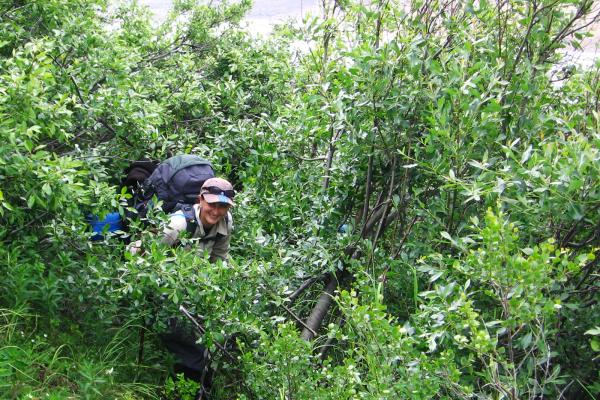When it comes to backcountry, wilderness travel, there are normal trail miles and then there are Alaskan miles.
Understanding what makes an Alaskan backpacking trip different from others will help you to adjust your expectations and be better prepared mentally and physically.
The big difference in Alaska is the trails - there aren’t any. Near Anchorage there are accessible trailheads with trails that can get you a day or two into the backcountry. But that accessibility means you will have lots of company on the trail which is not why you come to Alaska.
To access deep backcountry means leaving trailheads behind and getting into a single engine bush plane. When that plane drops you off at some remote airstrip (two worn spots on the tundra) and disappears over the ridge, you will definitely feel that you are more remote than you have ever been. And once you start walking you will quickly learn about the Alaska mile.
The lack of a path is a total game-changer. Even if the terrain is smooth, firm and level tundra, it’s still not the same as a trail and will slow your pace considerably. And of course it’s rarely all of those things and more likely to be rough, rocky, uneven, up, down and constantly changing.
When you’re hiking on a trail, even with a heavy load, you can develop a rhythm and a pace due to the regular surface. But with constantly variable and challenging terrain, progress is slowed way down. Toss in obstacles like boulder fields, brush choked valleys, glaciers, moraine and stream crossings and you find that your daily mileage in the lower forty eight of 12-15 miles has dropped to just a few Alaska miles per day.
In the Alaska backcountry forward progress is not about pace or speed of walking. It’s about learning to read the terrain and move efficiently. When you’re toping out on a ridge take a break and utilize the vantage point to scout out the valley you are preparing to descend into. If there is a stream at the bottom scan for a spot that looks good for a crossing. Maybe you can see a way to skirt around that thicket of brush or boulder field.
Learning to move efficiently in the backcountry can take a bit of conscious effort initially. Sometimes it’s more a matter of human psychology than hiking technique.
People not used to backcountry travel find it more difficult than expected and welcome any opportunity to take a break. Breaks are good and necessary to maintain a good rate of travel. But left to their own devices, most people will take longer and more frequent rest stops than needed. Humping up a steep ridge with a full pack is tiring and you do need rest breaks. But often all that is really needed is a short stop of a few minutes to catch your breath before carrying on up the hill. What you need to limit are the pack-off, take a seat breaks. Pack off means easily a 15 to 20 minute stop. You do need some of those throughout the day for sure, but if you are taking a couple of those per hour you are adding a lot of extra hours to your day’s travel. So take pack-off breaks sparingly and do more short, standing stops.
In the Alaska backcountry there aren’t any nice log bridges over the streams. You have to find a safe spot, swap boots for water shoes and make your way across. By the time all is said and done probably half an hour will elapse in the process. Since the stream is forcing a delay, perhaps you can combine it with your lunch break. If you are 20 minutes away from a stream crossing don’t stop for a pack off break - push on and incorporate a break into the crossing.
When it comes to moving through the backcountry, slow and steady is the way to go. Learning to move efficiently can mean the difference between reaching your daily objective around 4:30 or cleaning your dishes in the dark
Try to prepare for backcountry travel by finding ways to adjust your training program. Any training you can get with a full pack and off-trail is going to pay dividends. Depending on where you live, off-trail hiking might not be possible. At the least you want to get in some miles hiking uphill with a full load and seek out more rugged terrain. Some tougher training miles might give you a leg up when confronting those longer, Alaskan miles.
Your body tries to be efficient in its use of muscles and energy. It likes to perform tasks with the minimum amount of muscles.l When you walk down a sidewalk or a nice trail, there are some muscles such as hip flexors that aren’t called into action very much. But on an irregular surface, such as you find in the backcountry, they are utilized to help maintain balance. If those muscles weren’t getting used in your life back home, you’ll feel the strain from off-trail hiking.
So do your best to prepare by spending some hiking miles on rough ground. As you pick your way across an Alaskan backcountry boulder-field you’ll be glad you did.




